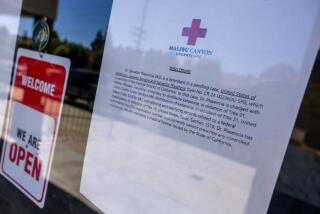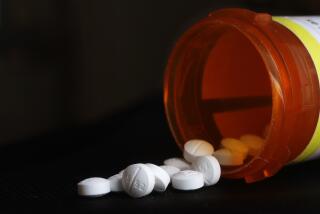Drug Abuse by Doctors a Malady of the System : Medicine: Some physicians overprescribe--and use substances themselves. It’s a threat, but one with low priority, regulators say.
WESTLAKE VILLAGE — It’s been six years since a computer monitoring the rate at which doctors prescribe narcotics kicked out the name of Dr. Stephen Cech. But the disciplinary hearing for the Westlake Village general practitioner, who was sanctioned for writing fraudulent prescriptions and using drugs in 1980, will not be held until next March.
Cech is accused of dramatically overprescribing Demerol, methadone and tranquilizers for four patients, at least one of whom, state regulators say, still may be addicted. But his case carries low priority in a system already overwhelmed by doctors accused of far worse things.
Doctors who abuse drugs or overprescribe, regulators say, are a problem, but less dangerous than physicians who are severely neglectful or incompetent.
But drug abuse experts say that the culture of the medical profession can lead doctors, more so than the rest of the population, not only to abuse drugs themselves but to overprescribe to others. Fully 18% of doctors, or 14,000 of the 77,000 practicing in California, will develop chemical dependency problems at some point in their lives, according to a 1994 report by the Medical Board of California. And the percentage is much higher among specialists whose work involves treating patients with narcotics.
By contrast, about 16% of the general public develop such problems. According to a 20-year study of Harvard undergraduates, those who went on to become doctors were twice as likely as the others to abuse tranquilizers and sleeping pills.
For his part, Cech, who completed a treatment program for drug abusers in the early 1980s, has denied allegations that he overprescribed narcotics to his patients. He is expected to argue at his March hearing that patients needed the drugs to cope with severe pain.
His attorney, Henry Lewin, says there is no connection between the “tragic situation” of Cech’s own abuse of prescription narcotics in the late 1970s and the current accusation of overprescribing. Neither Cech nor Lewin would comment further.
His case, though, is illustrative. Even if innocent, Cech will have endured two years during which any potential patient who has chosen to call the state to check his record has learned not only of his prior record of abuse, but of the allegations against him. If the state is right, the case points up the problems of doctors, drugs and a prevailing sense among physicians and those who regulate them that overuse of chemicals is not a terribly important concern.
The problems of doctors’ abuse and overprescription of mood-altering drugs like tranquilizers and amphetamines have their roots in the way doctors are trained, said Robert Coombs, a professor at the UCLA School of Medicine who specializes in researching substance abuse among medical professionals.
Medical students are taught that pharmaceuticals often can be the answer to patients’ problems, Coombs said, but there is remarkably little instruction on the nature of addiction.
“These people don’t know thing one about chemical dependency,” he said, adding that the problem is not taken seriously enough. “They have outrageous slang terms for people who have a [chemical] problem.”
Some schools, including UCLA, have begun to teach about addiction, but “it’s moving from total ignorance to just gross inadequacy,” he said.
And there seems to be a correlation between overprescription and doctors’ use of drugs. “The guys who are using themselves do seem to be far more likely to be handing out stuff to patients,” said state Deputy Atty. Gen. Mark Roohk, who prosecutes cases of alleged physician misconduct.
“People come to doctors’ offices and they feel jilted if they don’t leave with a prescription,” said Coombs. “And physicians figure that if it’s good for their patients, it’s good for them. They try to manage their lives with pharmaceuticals.”
Last year, 41 doctors were disciplined in California for overprescribing drugs to patients, and 23 for abusing drugs themselves. But those numbers are deceptively low.
Since 1980, 742 doctors have entered a program set up by the state medical board to help doctors kick the habit, said Chet Pelton, who heads the program. At any one time, though, 1,560 physicians in the state need help, according to a recent report by Pelton and his staff.
Most doctors who have participated in the Diversion Program have been what Pelton calls “poly-drug abusers,” people who abuse a variety of drugs. About half used alcohol, either in combination with drugs or alone.
Of 202 drug- and alcohol-abusing doctors in the program last year, 134 used prescription narcotics, including Demerol and Vicodin. Forty-three used cocaine and 18 used marijuana.
Not surprisingly, the rate of drug abuse is highest among doctors who are routinely exposed to mood-altering drugs at work. For example, there were four times as many anesthesiologists enrolled in the state Diversion Program as doctors in other specialties, Pelton said.
Following anesthesiologists were general practitioners and emergency-room doctors, he said. Obstetricians / ynecologists also ranked relatively high.
“Doctors are familiar with drugs and they think they have knowledge that will prevent them from getting addicted,” Pelton said.
Many of the doctors who develop dependency problems started abusing drugs in medical school or during grueling training periods as resident physicians in hospitals.
Not all doctors who have drug problems come to the attention of state regulators, said Pelton. And even when the state finds out, it can be difficult to assemble a case, said medical board enforcement chief John Lancara.
First, Lancara said, the addiction or tendency to overprescribe must be documented. In the case of an addicted physician, the process typically begins either with a complaint from a patient or when the doctor turns himself or herself in. In many cases, however, the problem does not come to the state’s attention until an incident occurs, such as a drunk-driving arrest, that makes the doctor’s problem public.
The progress of cases is further slowed by a lack of resources at the medical board.
The agency has 69 investigators to police 77,000 doctors, said Lancara. With 2,152 investigations currently open, that means that each investigator has a load of 31 cases.
Once an investigation gets going, it sometimes can take months or years before some doctors surrender the medical records necessary to make a case. Investigators are so overworked, Lancara said, that it’s hard to keep them.
Cech’s case dates back to 1989, when a state monitoring program first noted what appeared to be a large prescription of the painkiller Percocet. In 1991 an audit was conducted and the information was turned over to the medical board for investigation. It took two more years for the investigation and another two years before a hearing was set.
The case took too long, conceded medical board spokeswoman Candis Cohen.
The problem of slow disposition of discipline cases has dogged the medical board for at least the past three years. In 1992, the agency’s executive director, Ken Wagstaff, resigned after months of controversy over slow disposition of cases and allegations of impropriety by medical board officials.
“It’s a different board and a different enforcement officer,” said Robert Fellmeth, director of the Center for Public Interest Law at the University of San Diego. “It’s more an issue of resources, structure and authority. Before, it was one of will as well.”
Doctors can also slow down the process by requesting that their hearings be put off. Cech, for example, was scheduled for a hearing Sept. 12. It was delayed until March because the doctor reported Tuesday afternoon he had been hospitalized with a bad back.
But both Cohen and Lancara say that drug cases are lower on the agency’s priority list than cases in which doctors have wrought grievous harm.
“I can take [drug] cases to the attorney general, and he’ll say, ‘Which do you want me to do first? This or a wrongful death?’ ” Lancara said.
UCLA’s Coombs, however, said that it can be dangerous to relegate drug cases to the bottom of the list.
Patients lives can be ruined through addiction, he said, and doctors who are drug-addled while practicing medicine can cause serious harm.
“It is not only their lives, but their patients’,” Coombs said. “I can’t tell you how many people I’ve interviewed who’ve said they did surgery and had blackouts. It is scary.”
(BEGIN TEXT OF INFOBOX / INFOGRAPHIC)
Doctors on Drugs
The number of doctors disciplined for taking drugs or overprescribing drugs them to their patients is going up, but still does not reflect the ranks of physicians who have drug problems. According to the state medical board, 18% of doctors in the state will have a drug or alcohol problem at some point in their careers.
DISCIPLINARY CITATIONS
*--*
92-93 93-94 94-95 For self-use 10 14 23 For overprescribing 16 36 41
*--*
Source: Medical Board of California
More to Read
Sign up for Essential California
The most important California stories and recommendations in your inbox every morning.
You may occasionally receive promotional content from the Los Angeles Times.










